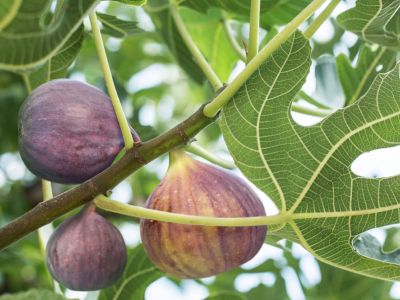During a recent warm summer in Provence, we plucked figs from a tree every day for a delicious and healthy no-fuss dessert. Figs are fun and fairly easy to grow, but there are a few important things to learn about fig tree care.
How to Grow Figs in the Garden
Buy your plants from a reputable nursery to avoid nematode problems with your figs. Other ways to obtain fig trees is to plant root suckers from other trees or obtain divisions or cuttings from mature plants. Plant new fig trees outside when they’re dormant. The best times are late fall or early spring. While some types will do well in cooler temperatures, most fig tree varieties will be happiest growing in USDA zones 8 through 10. If you live in a cooler zone, you can plant figs in half-barrels or moveable containers so they can be shrouded and protected from freezing in winter. It’s essential to keep them safe from cold wind and frosty conditions, which means that in many zones you’ll need to make them portable. It’s easier to protect a fig from the cold if it’s trained as a shrub or bush. Conversely, while it’s a warm weather fruit, the edible fig needs around a hundred hours of chilly weather to grow and set fruit. Set out your dormant, bare rooted fig trees in late fall to early spring. In addition to full sunlight, fig trees appreciate lots of room. If you’re planting more than one tree, make sure they have 15 to 20 feet (5-6 m.) between them. If you want to train the trees to be bushy and lower growing, plant them with 10 feet (3 m.) between them. Your soil should be loamy, fertile, and well-drained with a pH balance of around 6.0 to 6.5. Clay heavy soil can prove to be a death sentence for your tree, so be sure to dig in plenty of organic material, like compost or well-rotted manure before you plant.
Fig Tree Maintenance
Newly planted fig trees should be pruned back by about a half. This may seem distressing, but it will give the young tree the ability to concentrate on establishing strong roots. Your fig probably won’t bear fruit until the second or third year, so this early pruning provides a strong head start. After the tree is established, it should be pruned in late winter each year, just before it comes out of dormancy. Feed your fig tree with one pound (0.5 kg.) for each year of the tree’s age or per each foot (31 cm.) of growth using a balanced fertilizer.
Continued Fig Tree Care
The roots of a fig tree tend to grow close to the surface of the soil. Regular watering during the growing season is imperative. Mulching with straw or grass clippings can help keep the roots moist. Dry roots can lead to premature fruit drop. While fig trees don’t have many natural enemies, they can develop some problems. The most common issue for fig trees may be root-knot nematodes. Be sure when purchasing a new fig tree that it doesn’t already have this problem by examining the roots before transplanting into the ground or container. Although too much water can drown a fig tree’s shallow growing roots, regular watering and mulching can keep the tree healthy. Other less frequent potential diseases include:
Fig Rust Fig Souring Fig Mosaic Leaf Spot Pink Limb Blight Cotton Root Rot
Figs are ready to harvest and eat when the fruit has softened. They won’t ripen once they’re picked from the tree and unripe figs aren’t very tasty. Ripe figs, however, are exceptionally sweet and delicious.
